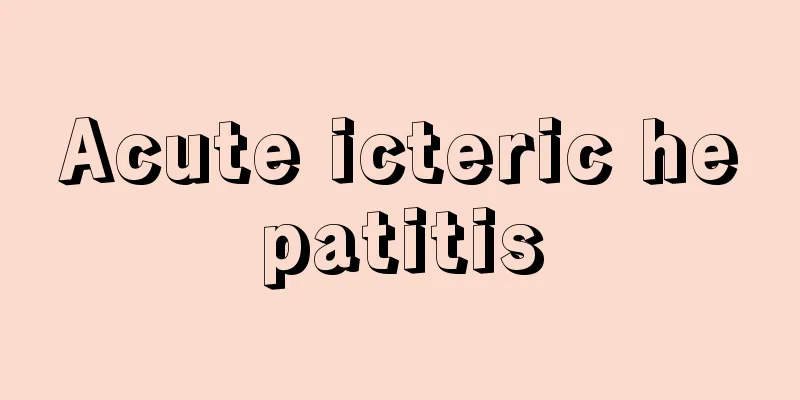Acute icteric hepatitis

|
There are already many patients with acute hepatitis. Our lives will be affected a lot after suffering from hepatitis, and this disease is contagious. We must take precautions in our daily lives. Acute icteric hepatitis is a very common type of acute hepatitis. It has many causes. Generally, the course of the disease lasts for 2 to 4 months. In the early stages, there will be symptoms of joint pain and low fever. Acute icteric hepatitis is a relatively common disease at present. Patients will experience many uncomfortable symptoms. This disease is also divided into different stages, including the pre-jaundice stage, the jaundice stage, and the recovery stage. It is necessary to check in time. There are many examination items and make scientific treatment. Acute icteric hepatitis is a type of acute viral hepatitis, an acute gastrointestinal infectious disease caused by hepatitis virus. The clinical manifestations are acute onset, loss of appetite, aversion to oil, fatigue, upper abdominal discomfort, dull pain in the liver area, nausea, vomiting, chills and fever in some patients, followed by darker urine color and jaundice on the sclera and skin. Modern acupuncture treatment for this disease began in the early 1950s. After 1958, reports with a certain number of samples appeared one after another, but it failed to be promoted. Since the late 1970s and early 1980s, acupuncture treatment of this disease has received great attention from the medical community. Clinical and experimental research has been widely carried out in more than 10 provinces and cities including Shanghai, Hubei, and Jiangsu, and significant results have been achieved. According to clinical data statistics in recent years, the cure rate of acupuncture for this disease is about 85%, both in the short and long term, for both adults and children[1]. Not only does acupuncture have a low recurrence rate, but it is also superior to traditional Chinese medicine or Western medicine in terms of restoring appetite, alleviating jaundice, and improving liver function [2]. Of course, acupuncture treatment of acute icteric hepatitis also has certain indications. It is generally suitable for common cases, and acupuncture is only one of the comprehensive measures for severe patients. Secondly, even if it is a common type, it is best to be simple and not have mixed diseases. In addition, acupuncture treatment of acute non-icteric hepatitis is not as effective as that of icteric hepatitis. At present, the generally accepted criteria for acupuncture indications in my country are: (1) the course of the disease is less than 2 weeks; (2) the patient has the above-mentioned typical clinical symptoms; (3) physical signs include liver enlargement, local tenderness and percussion pain, and jaundice; and (4) two or more abnormal liver function tests. The mechanism of action of acupuncture in treating acute icteric hepatitis is still unclear. Some people believe through experimental studies that acupuncture may be one of the factors that promote the reduction of jaundice through its choleretic effect; and observations from lymphocyte transformation tests suggest that the effect of acupuncture may be related to improving the body's specific immune function. Staging The course of acute icteric hepatitis can be divided into three stages according to clinical manifestations. The stages are quite distinct and the total course is about 2-4 months: (1) Pre-jaundice: A few days to 2 weeks. Most symptoms appear slowly, and most patients first feel general fatigue, followed by loss of appetite, aversion to oil, nausea and vomiting, abdominal distension, and even inability to eat. Children often have low fever, about one-third of patients have moderate fever, and some have high fever with chills, which is a remittent fever. Because the symptoms of each patient are not exactly the same, they are divided into the following types based on the prominent clinical symptoms at the onset: some patients have indigestion type with mainly gastrointestinal symptoms; some patients have influenza type with fever, headache, and upper respiratory tract symptoms; some patients have biliary disease type with severe upper abdominal pain accompanied by chills, high fever, jaundice, and leukocytosis; some patients have rheumatic type with early symptoms of joint pain and fever; and some patients have sepsis type with chills, remittent fever, and rapid onset of jaundice. Some patients also have an onset similar to malaria or encephalitis; 4%-5% of patients may have urticaria, papules and erythematous skin rashes. Children may experience swollen lymph nodes at the back of the neck. These show that the symptoms of hepatitis patients are extremely complex. In addition to having commonalities, they also have their own characteristics. Only by fully understanding the complexity of the acute phase of hepatitis can early diagnosis be made. (2) Jaundice stage: About 2-6 weeks. The main manifestation is the appearance and deepening of jaundice. The urine turns yellow first, followed by yellowing of the sclera and skin. The jaundice worsens and reaches its peak within 1-2 weeks. As the jaundice deepens, it will continue to be noticeable in some patients for about 2-6 weeks before gradually disappearing. At this time, most patients no longer have fever. The patient had light-colored stools, an enlarged and tender liver, itchy skin, and bradycardia. Some patients may have short-term obstructive jaundice, clay-colored stools, and obvious liver function damage. Jaundice reaches its peak and begins to subside, and gastrointestinal symptoms improve, such as appetite begins to recover, and other symptoms also begin to alleviate. Clinically, jaundice can be divided into four different types according to its characteristics, namely mild jaundice, ordinary jaundice, long-term jaundice, and recurrent jaundice. (3) Recovery period: Once the jaundice subsides, the recovery period begins. About 2 weeks to 4 months, average 1 month. The above symptoms usually begin to disappear in about 2 weeks. Children have a shorter course of illness and recover quickly, recovering in about 1-2 months. About 5% of adults experience long-term pain in the liver area, or discomfort, loss of appetite and fatigue, which is often called post-hepatitis syndrome. In the early stages of acute icteric hepatitis, there will be many symptoms such as vomiting, nausea, arthritis, urticaria, etc. Sometimes these symptoms are easily confused with other diseases, so they cannot be treated in time. If such symptoms appear, you should go to the hospital for relevant examinations in time to avoid serious harm caused by untimely treatment. |
Recommend
Why can't I sleep soundly?
Sleep quality is very important for people of all...
What is the best way to treat mysophobia and obsessive-compulsive disorder
Obsessive-compulsive disorder (OCD) is not uncomm...
How to treat eye papillae
Normally our eyes are composed of a black pupil a...
The difference between black tea and Pu'er tea
From an outsider's perspective, there is not ...
Can I drink alcohol if I have otitis media?
Otitis media is a common ear disease. Although ot...
Things to note about the sequelae of prosthetic chin
In fact, many people now pay great attention to t...
There is white stuff in the stool
The color of stool is an important reference cond...
What is the reason for the dull pain in the right kidney
If you have a dull pain in the right kidney, you ...
What should I do if my hair is thin and falling out
If your hair is thin and prone to hair loss, you ...
Factors that cause eye pain when wearing orthokeratology lenses
People who wear glasses frequently know that wear...
What are the symptoms of chronic appendicitis?
Everyone is familiar with appendicitis. Many peop...
What is the cure rate for testicular cancer
For patients, the cure rate has become the most c...
What causes genital herpes? It turns out to be these 5 reasons
Herpes is a common skin disease in daily life and...
Where does prostate cancer usually manifest itself?
Prostate cancer is a disease with a higher incide...
How to open the shell of scallop
Scallops are a delicious and nutritious food. It ...









